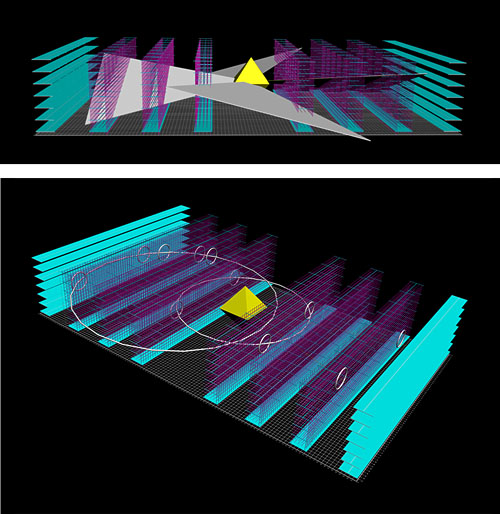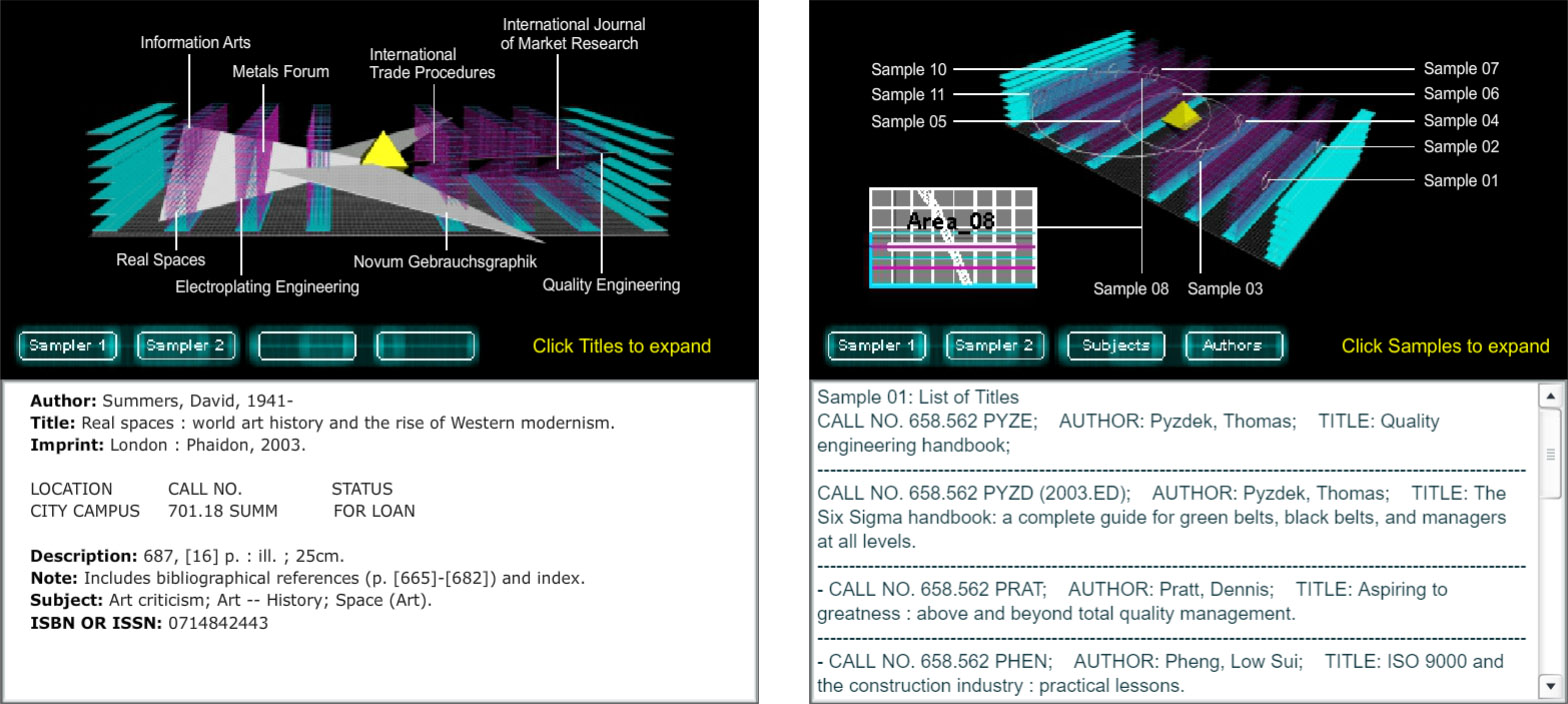Tetrahedron
The project presents the opportunity to undertake primary research in the exploration of a specific environment and to identify and conceptualise an original project whose primary aim is to reveal previously unknown aspects of the UTS library (UTS Course Description, 2006). The Tetrahedron Project explores a virtual information space defined by:
- A parameterized Volume, or space of actions;
- The library User;
- Forms and modes of Interaction;
- Transformation operations, morphological events.
Apart from describing processes of virtualisation [card swipe, terminal login, catalogue search, digital persona], the project
proposal introduced the idea of a generative "structure' of forms" triggered as users locate their biblio-graphic resources in a
sensated space.
The actual prototype built for this project actuates datagraphic iterations based on the spatial distribution of, and parameterized
relations between, a collection of shelved books. Library users interacting with a 3-D model (via a 2-D Flash interface) can apply a
number of Samplers in order to access summary information on titles and subjects.
CONTENTS
1 Objective
The objective was to explore aspects of a speculative interface superimposed onto a parameterized physical space by means of a wireless
LCD eyewear system (head-up display). Information thus obtained might facilitate correlations and 'geographic inferences' regarding the
[tagged] book collection as a whole. At the same time, the graphic transformations resulting from a given user interaction could provide
fresh interface components during subsequent states of the system.
The project aims for a subtle equilibrium between visual design solutions and alphanumeric intelligence.
2 Concept
The Tetrahedron datagraphic system is informed by generative geometry, as well as form-finding techniques used in digital
architecture (e.g. parametric design). It might be considered self-sufficient, or cybernetic, because it can alternate indefinitely
between: i. generating new geometric shapes and ii. generating fresh constellations of positional-
and catalogue data. The Prototype is based on:

- A parameterized physical space;
- Coordinate and relational data;
- A 3-D model;
- Rules and algorithms;
- A 2-D Graphic User Interface.
As already indicated, users access information on titles and subjects using a 2-D interface built with Macromedia Flash 8. This
interface is divided into:
(1) a window to display datagraphics, user buttons, status information and, (2) a text area for
catalogue information and [pseudocode] algorithms.
A parametric Shape Generator was conceived to show how Subvolume 658-709 [of the library] might be scanned:
Sampler 1 thereby defined eight point-accurate resource locations, while
Sampler 2 takes a large sample from a number of [30cm-radius] areas.
The algorithms [envisaged] to 'drive' the Samplers as they 'collect' titles and XYZ triplets, {query the catalogue for relational data},
and respond by changing shape, are also displayed. A completed iteration prompts users to access catalogue information by clicking a
set of links. More advanced versions should incorporate direct user input.
3 Method
a) The Proposal outlined the following Scope of Work:
- Conduct primary and secondary research;
- Idea, Concept, Methodology; Analysis, Meditation, Brainstorming;
- Establish basic project components [User, Space, Interaction, Transformation];
- Determine media outcome of final submission; Select 3-D modeling software;
- Measure individual rows and shelves of the physical space; Produce sketches on paper;
- Convert analogue dimensions; Construct Cartesian frame; Build model using Autodesk 3ds Max 8;
- Test 3-D model; Render example views;
- Analyse library catalogue to establish potential parameters;
- Select books; Compile positional- and parameterized catalogue data;
- Write pseudocode algorithms; Execute each iteration of the prototype in 3ds Max;
- Record steps in 3ds Max using the timeline; Store emerging co-ordinates of new titles;
- Conduct user testing;
- Assemble datagraphics; Compile component deliverables; Construct HTML/CSS webpage.
b) Shelving of Subvolume 658-709 was measured and a 3-D model constructed using Autodesk software. The transfer of
positional data was facilitated by "[discretizing] each slice on a given grid, the stack of the successive slices providing
an array of elementary volumes." (Robotics and Artificial Intelligence, 1984)
c) The transformation constituting our first iteration [Sampler 1] was determined by the following
parameterized catalogue data:
Sampler_1_Iteration_1
IF NOT (CALL NO. < '658.45'2), (CALL NO. > '709.54/3') THEN
Clone triangle_01
AND Rename triangle_02
AND Rotate triangle_02 180 degrees
AND Display
ELSE
Display 'Input is out of range'
IF STATUS = ('FOR LOAN') THEN
Clone triangle_01
AND Clone triangle_02
AND Rotate shape_03 90 degrees
AND Display
AND Display XYZ co-ordinates of new titles
AND Store XYZ co-ordinates of new titles
ELSE
Display 'Title unavailable'
Get book_01_subject, book_02_subject
IF book_01_subject = 'art', book_02_subject = 'art' THEN
Scale diamond 600 percent
AND Display
ELSE
Display 'Subjects do not match'
ENDIF
ENDIF
ENDIF
4 Datagraphic Animation

5 Outcome
"In a sequence of psychological experiments, we showed that human vision represents a square generatively in the following way. It
begins with the top side. Perceptually the top side is generated by starting with a corner point, and applying translations to trace
out the side; next this translational structure is transferred from one side to the next - rotationally around the square."
(A Generative Theory of Shape, 2001)
Within a wider context of Augmented Reality, tagged objects, and sensor technology, the Tetrahedron project explored aspects
of a speculative interface superimposed onto a parameterized physical space. The timeframe and scope, however, have resulted in much
stubbed-out and/or simulated functionality ...
The actual prototype enabled users interacting with a 3-D model (via a 2-D Flash interface) to 'reconnoitre' a given virtualised space
[Subvolume 658-709 of the UTS Library] by applying a Sampler to access summary catalogue
information; the underlying parametric engine additionally refers to various form-finding techniques.
Author: Marcel Ritschel, Date: 29 October, 2006 (revised: 2013)
Project for Visual Information Systems 88911; University of Technology, Sydney
6 Bibliography
Boyles, M, Indiana University Advanced Visualization Laboratory: 3DIVE: AN IMMERSIVE ENVIRONMENT
FOR INTERACTIVE VOLUME DATA EXPLORATION. Retrieved October 10, 2004 from http://www.cs.iupui.edu/~sfang/cadcg.pdf
Corupe, P: 2004, The Name of the Rose, Retrieved September, 2006 from www.dvdverdict.com/reviews/
Donjon quadrangulaire, Ministère de la culture, Retrieved September, 2006 from www.culture.gouv.fr/
Entertainment Laser, Retrieved September, 2006 from http://lasyseurope.com
Generative Modeling, Caltech Computer Graphics Group, Retrieved September, 2006 from
www.gg.caltech.edu/genmod/gen_mod_page.html
Han, J and Kamber, M: 2001, Data Mining: Concepts and Techniques, Morgan Kaufmann Publishers.
Laser Display Systems Manufacturer, Retrieved September, 2006 from www.laser-innovations.co.uk
Leyton, M: 2001, A Generative Theory of Shape, Springer-Verlag.
Robertson, L: 2003, Simple Program Design, Thomson.
Snyder, J and Kajiya, J: 1992, Generative Modeling: A Symbolic System for Geometric Modeling, California Institute of Technology.
Stephen R. Wassell, "Book Review: A Generative Theory of Shape", Nexus Network Journal, vol. 6 no. 1 (Spring 2004), http://www.nexusjournal.com/reviews_v6n1-Wassell.html
Ware, C: 2004, Information Visualization, Elsevier Inc.
